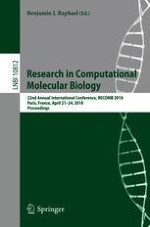2018 | Buch
Research in Computational Molecular Biology
22nd Annual International Conference, RECOMB 2018, Paris, France, April 21-24, 2018, Proceedings
herausgegeben von: Benjamin J. Raphael
Verlag: Springer International Publishing
Buchreihe : Lecture Notes in Computer Science
